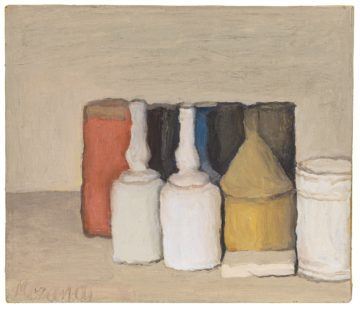Peter Schjeldahl at The New Yorker:
 Imagine bits of wood trapped in eddies of a stream, going round and round atop the waters that flow beneath them. The image comes to mind in response to a surprising show—surprisingly great, contrary to my skeptical expectation—at David Zwirner’s New York gallery. The works on display are by two artists who can seem bizarrely mismatched: Josef Albers, the starchy German-American abstract painter, Yale School of Art professor, and color theorist, who died in 1976, at the age of eighty-eight, and Giorgio Morandi, the seraphic Italian still-life painter of bottles, vases, and other sorts of domestic objects, who died in 1964, at the age of seventy-three.
Imagine bits of wood trapped in eddies of a stream, going round and round atop the waters that flow beneath them. The image comes to mind in response to a surprising show—surprisingly great, contrary to my skeptical expectation—at David Zwirner’s New York gallery. The works on display are by two artists who can seem bizarrely mismatched: Josef Albers, the starchy German-American abstract painter, Yale School of Art professor, and color theorist, who died in 1976, at the age of eighty-eight, and Giorgio Morandi, the seraphic Italian still-life painter of bottles, vases, and other sorts of domestic objects, who died in 1964, at the age of seventy-three.
In 1950, Albers wedded himself to a format of three or four nested, hard-edged squares on square supports—“Homage to the Square,” he called them—centered a bit below the pictures’ vertical midpoints. That was it, for him. His occasional departures from the formula in the following years availed little.
more here.
